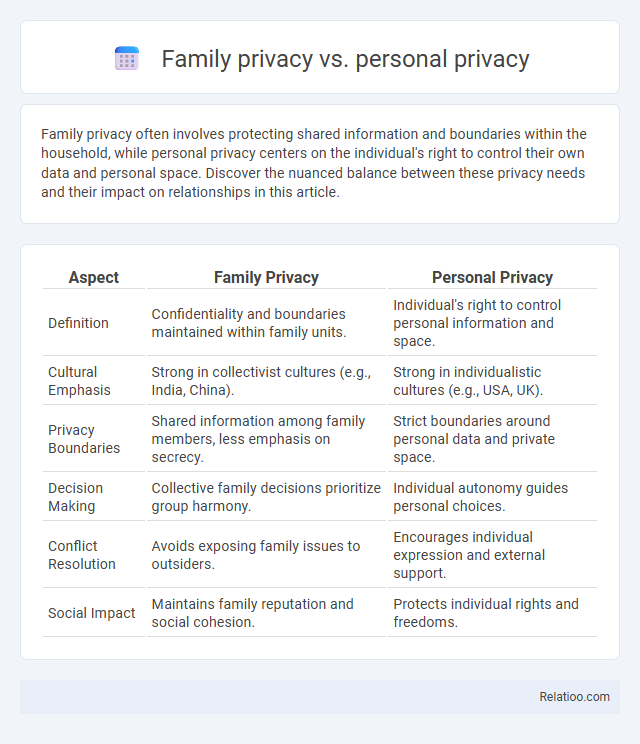Family privacy often involves protecting shared information and boundaries within the household, while personal privacy centers on the individual's right to control their own data and personal space. Discover the nuanced balance between these privacy needs and their impact on relationships in this article.
Table of Comparison
| Aspect | Family Privacy | Personal Privacy |
|---|---|---|
| Definition | Confidentiality and boundaries maintained within family units. | Individual's right to control personal information and space. |
| Cultural Emphasis | Strong in collectivist cultures (e.g., India, China). | Strong in individualistic cultures (e.g., USA, UK). |
| Privacy Boundaries | Shared information among family members, less emphasis on secrecy. | Strict boundaries around personal data and private space. |
| Decision Making | Collective family decisions prioritize group harmony. | Individual autonomy guides personal choices. |
| Conflict Resolution | Avoids exposing family issues to outsiders. | Encourages individual expression and external support. |
| Social Impact | Maintains family reputation and social cohesion. | Protects individual rights and freedoms. |
Understanding Family Privacy: Definition and Scope
Family privacy refers to the protection of personal information and activities shared within a family unit, ensuring that intimate details remain confidential among members. This concept encompasses boundaries around communication, behaviors, and shared spaces to prevent external intrusion or unauthorized disclosure. Understanding family privacy also involves recognizing cultural and legal norms that shape expectations and rights regarding private family matters.
Personal Privacy: Individual Boundaries and Rights
Personal privacy centers on protecting Your individual boundaries and rights, ensuring autonomy over personal information and activities. It requires clear limits that distinguish personal space from public and family domains, reinforcing control over data sharing and intimate decisions. Privacy norms evolve to balance respect for individual privacy with social expectations within families and communities.
The Intersection of Family and Personal Privacy
The intersection of family and personal privacy involves balancing collective confidentiality with individual autonomy, where sensitive information shared within family units demands careful protection to respect each member's rights. Privacy norms shape expectations by defining boundaries in communication, digital data sharing, and physical spaces among family members, often influenced by cultural and legal frameworks. Understanding this complex overlap promotes tailored privacy solutions that honor both familial bonds and personal freedoms in various social and technological contexts.
Common Conflicts Between Family and Individual Privacy
Conflicts between family privacy and personal privacy often arise from differing expectations about boundaries in shared living spaces and digital communications, such as parents monitoring children's phone usage versus respecting their autonomy. Privacy norms dictate acceptable behaviors within family units, but these norms vary widely across cultures and generations, creating tension when individual family members seek greater personal confidentiality. Balancing family cohesion with individual rights requires clear communication and mutual respect for both collective and personal privacy standards.
Digital Age Challenges: Online Sharing and Privacy
Balancing family privacy and personal privacy becomes increasingly complex in the digital age, where online sharing blurs traditional boundaries. Privacy norms evolve as individuals navigate social media, digital footprints, and data exposure, making it crucial for you to understand the impact of oversharing on both personal information and family dynamics. Protecting sensitive data while respecting each family member's privacy rights requires awareness of cybersecurity risks and adherence to emerging digital privacy standards.
Generational Views on Privacy within Families
Generational views on privacy within families reveal distinct attitudes toward family privacy, personal privacy, and prevailing privacy norms. Younger generations often prioritize personal privacy, valuing individual control over digital data, while older generations emphasize family privacy, focusing on collective boundaries and shared information. These differing perspectives shape evolving privacy norms, influencing communication patterns and the management of sensitive information across familial relationships.
Legal Protections for Personal and Family Privacy
Legal protections for personal and family privacy are established through laws such as the Fourth Amendment in the United States, which safeguards individuals against unreasonable searches and seizures. Family privacy is additionally protected by statutes addressing domestic matters, including child custody and spousal rights, ensuring confidentiality in family communications and home environments. Privacy norms influence legislation by reflecting societal expectations, but legal frameworks specifically define and enforce boundaries for personal and familial privacy rights.
Strategies for Respecting Privacy at Home
Establish clear boundaries by designating private spaces for family members to honor individual needs while maintaining family privacy. Implement communication rules that encourage open dialogue about personal information sharing, respecting each person's comfort levels and privacy norms. You can foster a balanced home environment by regularly reviewing and adjusting these privacy strategies to ensure mutual respect and understanding.
Navigating Privacy in Blended and Extended Families
Blended and extended families face unique challenges in balancing family privacy with personal privacy, as overlapping relationships increase the complexity of setting boundaries and sharing information. Privacy norms evolve to accommodate diverse family structures, emphasizing respect for individual autonomy while fostering trust and open communication. Effective navigation requires understanding the distinctions between collective family privacy concerns and individual members' rights to control their personal information within the family context.
Building Trust: Communication About Privacy Needs
Open communication about privacy needs fosters trust within families by clearly defining boundaries between personal privacy and shared family privacy norms. Respecting individual preferences while establishing mutual agreements on privacy practices helps prevent conflicts and promotes a secure environment. Consistent dialogue enables family members to adapt privacy norms that balance personal autonomy with collective respect.

Infographic: Family privacy vs Personal privacy
 relatioo.com
relatioo.com